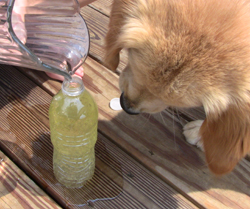Sometimes when atoms come together to form a molecule, one end of the molecule has a positive charge and one end of the molecule has a negative charge. When this happens the molecule is called a polar molecule. Molecules that do not have two different electrical poles are called non-polar molecules. For today’s demonstration you will make a lava bottle to observe polar and non-polar molecules.
This experiment will show you how polar molecules and non-polar molecules behave when added together. If two kinds of molecules are added together that are both polar molecules, they will mix. They are miscible. Miscible means that the two things can mix together. If two non-polar molecules are added together they will also mix and are miscible. However, if a non-polar molecule and a polar molecule are added together, they will NOT mix together. This is called imiscible. Imiscible means that the two kinds of molecules CANNOT mix together.
What You Need
- Plastic Bottle
- Water
- Vegetable Oil
- Food coloring
- Measuring Cups
- Alka Seltzer
Instructions to Make a Lava Bottle
Fill the bottle about 3/4 of the way up with vegetable oil. Fill the bottle the rest of the way up with water. Now add some drops of food coloring. Close the cap on the bottle and shake it up. What happens?
Break the alka seltzer tablet in half. Open the bottle and drop in one half. What happens? Once the bubbles settle down drop in the other half. What happens again?
Water is a polar molecule. Vegetable oil is a non-polar molecule. These two substances do not mix together, they are imiscible (they will not mix together). That’s why you see the blobs of water bobbing around in the oil. Food coloring is a polar molecule so it WILL mix with the water. The water and the food coloring are both polar molecules and will mix together. That’s why the water blobs turn the color of the food coloring and the oil does not.
The alka seltzer just makes the lava bottle more fun because it makes the colorful water blobs move without shaking the bottle. The alka seltzer tablets dissolve in the the water and make carbon dioxide gas (like we saw vinegar and baking soda do in the Exploding Ziploc experiment). The carbon dioxide gas bubbles attach to the colorful water blobs and make them float to the top of the bottle. When the gas bubbles pop there is no gas bubble to hold up the water blob, so it slowly floats back down to the bottom of the bottle.
Websites, Activities & Printables
- National Geographic for Kids: Groovy Lava Lamp
- Steve Spangler Science: Make Your Own Lava Lamp
- Science Bob: Blobs in a Bottle
- Exploratorium: Glitter Globe
- Glasgow Sciece Center: Lava Lamp
- Science Fun for Everyone: Lava Lamp

You can also ask a math and science expert for homework help by calling the Ask Rose Homework Hotline. They provide FREE math and science homework help to Indiana students in grades 6-12.
e-Books and Audiobooks
Use your indyPL Library Card to check out books about Science Experiments at any of our locations, or check out science experiment e-books and audiobooks from OverDrive Kids right to your device! If you have never used OverDrive before, you can learn how to use it for both e-books and audiobooks.
Need more help? Ask a Library staff member at any of our locations or call, text or email Ask-a-Librarian. Additionally, the Tinker Station helpline at (317) 275-4500 is also available. It is staffed by device experts who can answer questions about how to read, watch and listen on a PC, tablet or phone.
Atoms, Molecules and the Elements in the Periodic Table for Kids
The photographs, diagrams and creative storytelling in these books make the building blocks of the universe understandable…and fun! Find out about the scientists and discoveries which helped us find out what makes up all the stuff of the universe.

